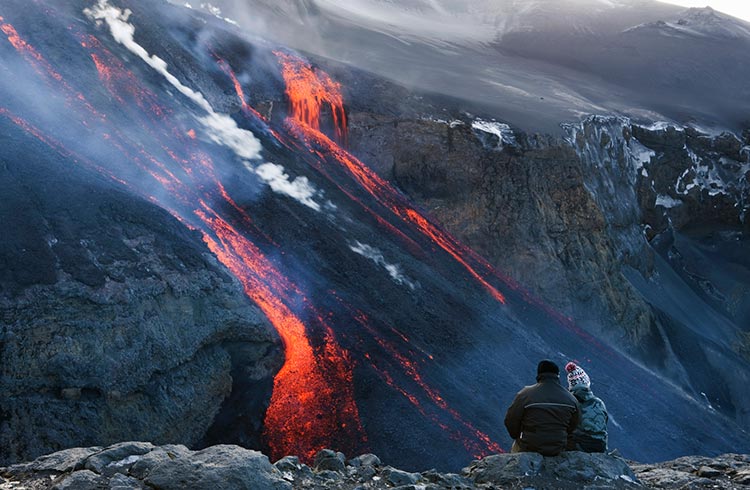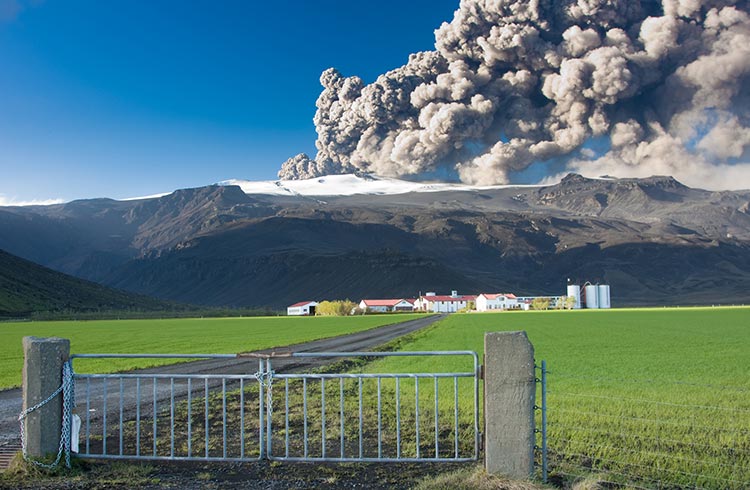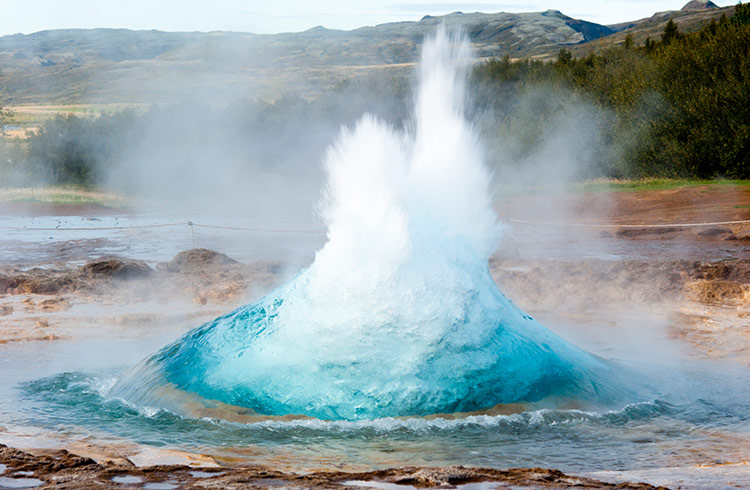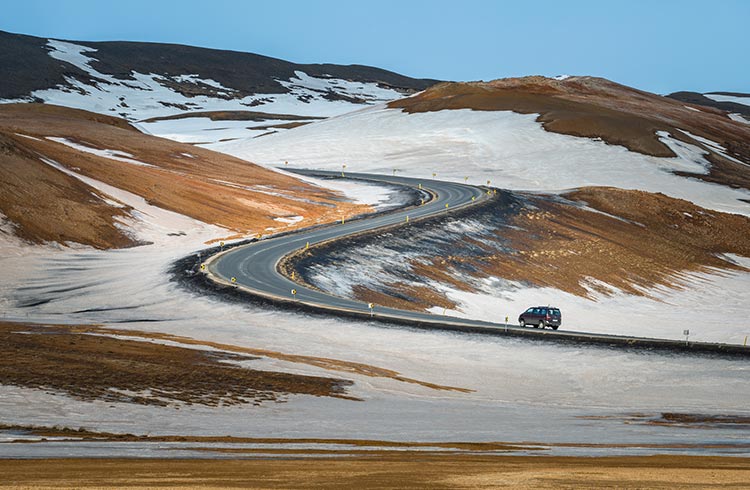Natural Hazards in Iceland: How to Stay Safe When Traveling
With spectacular landscapes and geological formations, here's what you need to know about staying safe while sightseeing Iceland's steaming geysers, frozen glaciers, volcanoes and lava fields.
 Photo © Getty Images/Atli Mar Hafsteinsson
Photo © Getty Images/Atli Mar Hafsteinsson
Iceland is full of natural beauty, but it is also full of natural hazards, which are perhaps its number one draw card. Some of the worst dangers pertain to geysers, which erupt and burn travelers each year. Other travelers have accidently become injured stepping into a hot spring or boiling mud pool. Few of these areas have warning signs or protective barriers against falling or getting injured, which is why some people get too close. The responsibility of safety lies mainly on the traveler.
However Iceland has one of the world's best monitoring systems for its natural hazards, and their emergency rescue services are of a very high standard due to skill and experience in dealing with the variety of hazards which pose a risk to human and animal life.
Here are our top tips on how to enjoy Iceland's amazing natural wonders without getting injured.
- Volcanoes in Iceland
- Volcanic mud and Jokulhlaups
- Icelandic geysers and waterfalls
- Don't get swept up taking a selfie at the beach
- Weather in Iceland
Volcanoes in Iceland
Iceland is one of the world's youngest countries geologically, and is geothermally active. It has 30 active volcanic systems comprised of approximately 130 volcanoes within four volcanic zones. Often when one volcano has erupted, the eruption of a connecting volcano will usually follow.
But volcanoes are just one of the reasons travelers go there each year. With volcanoes comes danger and potential disruption to your trip. Iceland has some of the best volcano experts in the world and many of the country's major volcanoes are monitored for signs of unrest.
Bardabunga, located under Iceland's largest glacier, Vatnajokull, erupted in 2014 after consistent earthquake activity. It also caused a significant lava flow and continued for six months. Scientists have since been monitoring signs of unrest with the volcano.
In May 2011 the Grimsvotn volcano eruption ejected a large amount of gases and ash into the air, causing further chaos in the European air space.
Grimsvotn is considered to be Iceland's most active volcano, and also lies under Vatnajokull, posing a flood risk should the volcano erupt.
In spring 2010, the now infamous volcano with its tongue twisting name, Eyjafjallajokull erupted, lasting for a period of six months. By eruption standards, this was quite small but big enough to cause significant delays with over 100,000 flights in Europe to be canceled due to the large plumes of volcanic ash continually ejected into the atmosphere.

Iceland's volcanoes like to throw the European air traffic network into chaos.
Given many volcanoes lay under glaciers, an eruption can cause the glacier to melt often resulting in large volumes of melt water rushing towards roads, homes and out to the ocean. But it can also result in another associated hazard.
Volcanic mud and glacial outbursts
Volcanic eruptions can also mean additional hazards such as volcanic mud flows (lahar) and jokulhlaups (Icelandic term for glacial outburst floods).
Volcanic mud flows can be a slurry of hot or cold volcanic materials, gases and water. Generally they will flow downslope of a volcano and make their way into a nearby river.
A lahar can also occur without a volcanic eruption due to warm weather melting snow and glaciers or increased rainfall eroding the volcano's slopes. They can also be triggered by earthquakes, something which Iceland gets plenty of, given the country straddles two tectonic plates.
Jokulhlaups are another associated risk with volcano eruptions. In 2010 when Eyjafjallajokull erupted, it caused the Gigjokull glacier to melt creating a jokulhlaup flowing at 2000-3000m per second at its peak. The eruption forced an incredible amount of water through a crack, flowing out across nearby plains to the ocean. To control the flow, authorities had to blow up a nearby road which cut through the plains area to assist with water flow.
It's important that if you are stuck in an eruption and at risk of a lahar or jokulhlaup, not to stand in low lying areas or in valleys. Seek shelter on higher ground. Or if possible evacuate the area.
Icelandic geysers and waterfalls
All "geysers" or hot springs in the world come from the Icelandic word "geysir". Geysers are everywhere in Iceland and while they are spectacular to watch especially Strokkur, located in the Golden Circle area, it is very important to stay safe around them. Annually, tourists are scalded and burnt by geysers whether inadvertently stepping into a hot spring in an active area or ignoring cordoned off areas and standing too close to the action

Tourists are strongly advised to stick to signed and marked paths. Off the path, the ground underfoot can be thin and next thing you know, you're waist deep in scalding hot water.
Take additional caution if visiting geysers on windy days as the hot steam and water can be blown around, resulting in a nasty burn.
Waterfalls and slippery slopes can also pose imminent danger. They are beautiful to behold in their natural glory, no railings or ropes cordoning off the precipitous heights. But beware! The rocks are sharp and the currents quick. In July 2017, a man fell to his death at one of Iceland's most visited waterfalls, Gullfoss, plunging 70m. So please keep a safe distance from the edge.
Don't get swept up taking selfies at the beach
The waters around Iceland can be as unpredictable as the weather. Thousands of tourists flock to South Iceland's black volcanic sand beaches near Vik to drink in the view of the mighty North Atlantic Ocean and towering basalt columns. Unfortunately though, some have not lived to tell the tale while trying to get that prize holiday pic after being grabbed by what locals refer to as sneaker waves and dragged out to drown in the freezing rough water.
In January 2017, a German woman traveling with her family got caught by a large wave, drowned and sadly washed ashore two hours after. Her son also was caught by a wave but managed to survive and get back to shore. The weather was picture perfect that day.
Despite the warning signs, many people have died at Iceland's most dangerous beach, Reynisfjara, where powerful coastal waters pound the beach and surrounding rocks.
Other beaches to watch out for while visiting: Djupalonssandur, Kirkjufjara, Dyrhólaey Peninsula beach, Porsguen.
Weather in Iceland
Weather can be problematic for outdoor adventurers in Iceland, as conditions can change rapidly. High winds can whip up seemingly out of nowhere, with the rain and cold can quickly create icy conditions for hiking and driving. Glaciers, waterfalls, ice caves and glacial rivers may also make outdoor trekking dangerous, as can rough terrain.
Anyone planning to hike or backpack should practice the standard safety protocols before embarking: tell someone where you're going; pack proper equipment and safety gear, including items to alert someone you are in danger or stranded; check the weather reports and alerts on volcanic activity and earthquakes; and stay on designated trails. While Iceland's hospitals are considered good quality, they are spread out over the country, meaning injured and sick patients may need to travel far to get medical attention.
Weather is listed as a top concern by recent tourists to Iceland. Even the brightest of days can quickly turn brrr-level cold or dark with poor visibility.
Being near the Arctic Circle, the country can cop some decent storm action. If warnings are put out by the authorities, it is important you heed their advice. If the roads are closed, don't attempt to drive anywhere. Storms have blown vehicles including buses off the road in the past.
The temperatures aren't too extreme for many, dropping only a few degrees below freezing at their chilliest, but those from warmer or more temperate climates will need to brace themselves. Dress appropriately for the weather in layers which can be easily taken off or put on.
The greater danger is that rain and wind can appear unexpectedly, which poses problems for people doing outdoor activities or driving in remote areas without supplies.
While it's not a life threatening danger, Iceland's extreme periods of darkness and light can disrupt travelers' bio rhythms and make for an unpleasant trip where you're up all night thanks to persistent sunshine. Those prone to seasonal affective disorder may struggle with the 20 hours of darkness that descend upon this northern country in December.
But the upside of the long periods of daily sunshine, is that you are treated to some of the most spectacular sunsets around midnight.
Related articles
Simple and flexible travel insurance
You can buy at home or while traveling, and claim online from anywhere in the world. With 150+ adventure activities covered and 24/7 emergency assistance.
Get a quote
3 Comments
You can tell people abou risks so they are aware what is in Iceland. It is a beautiful country. Nothing to be afraid of. You can die there or you can be hit by a car. If you die you die. Of course this doesn't mean that you shouldn't be careful!
like the passage
i love this website